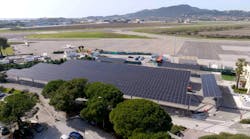Airports have not been immune to the global economic downturn of the past few years. Due to their heavy reliance on fuel flowage fees and aviation-related rental income, a decline in operations has pushed some airports to the brink.
The exceptions have been those airports whose leadership anticipated the slowdown and sought opportunities to diversify their revenue streams. This strategic thinking has resulted in some airports not only surviving but prospering.
Boca Raton Airport
A case in point is the Boca Raton Airport (BCT) located in South Florida. An independent special district with governing board members appointed by both the City of Boca Raton and Palm Beach County, BCT receives no ad valorem tax revenue from either and lacks the authority to levy its own taxes.
Instead, the airport is wholly reliant on revenues generated from fuel flowage fees and rental income. Traditionally, the airport’s rental income was derived exclusively from aeronautical uses. Given its prime location in the heart of Boca Raton, and its visibility from a major interstate highway, however, interest began to grow several years ago from potential non-aviation tenants.
The airport’s layout plan (ALP) included two parcels designated as non-aeronautical, revenue producing. Those highly-desirable landside parcels were developed into a movie theater and a family fun park. Even with the addition of these non-aviation uses, though, the majority of the airport's rental income continued to be generated by aeronautical uses.
The Airport contained only one remaining undeveloped parcel. That parcel had long been planned as the site of a future airport administration building. With a strong fiscally conservative approach, management initiated discussions with the governing board members that resulted in direction to examine the market and determine the highest and best use of the parcel.
At just under 5-acres in size, the options boiled down to an office use or a retail use, with the retail use promising the greatest potential revenue to the airport.
Armed with this information, the Federal Aviation Administration airport district office was consulted and eventually a formal request was made to amend the ALP to change the designation of the parcel to non-aeronautical revenue producing; FAA approved that request in 2007.
Intergovernmental Cooperation
The strategic shift evidenced by this process was not only creative and insightful, it was economically profound. Through its thoughtful anticipation, the airport had abandoned a project which would have weighed heavily on the expense side of its ledger (the design and construction of a new administration building) with no resulting income stream, and simultaneously paved the way for significant income generation.
In addition to the market research and coordination with FAA, the BCT was guided by a strong commitment to transparency and cooperation. From the inception of the concept, an agenda item focused on the parcel was placed on the governing body’s monthly agenda. Information regarding all stages of the project’s planning and development was disseminated and discussed, and public comment sought.
Additionally, specific stakeholders were consulted and involved. Given Boca Raton’s land use standards and building code requirements, specific attention was paid to coordinating the use and development of the parcel with City officials, while the County’s concerns regarding traffic and other impacts were addressed. Effective intergovernmental cooperation was integral to the success of this project.
With its market research and key approvals in hand, the airport then turned to its procurement code in order to assure a fair process. Its code permitted maximum flexibility in the advertisement of the parcel for development and use consistent with the marketability study, and development requirements.
In return, the airport received a variety of proposals for a wide array of commercial uses from which to choose. Armed with a team of experts, from financial to engineering to legal, BCT set out to thoroughly vet and evaluate the competing proposals. The evaluation process culminated with public presentations, with questions and input from a significant number of interested and impacted participants.
In late 2008, a unanimous decision was reached to select a tenant to develop and operate a large facility housing two furniture stores. A long-term lease was executed providing for an annual rent at the high-end of the range predicted by the marketing research. That project broke ground and was completed on time, and operates successfully today.
Prepared For The Downturn
In 2009, the economic slowdown was in full swing. Operations and fuel sales, long on an upward trajectory, began to flatten.
While many airports scrambled to shore up revenues, the Boca Raton Airport was prepared. At the conclusion of the past fiscal year, approximately 55 percent of BCT'ss revenue was derived from non-aeronautical, revenue producing tenancies.
Guided by a strong commitment to financial self-sufficiency, the Boca Raton Airport had planned ahead and secured its economic health, and that revenue diversity will serve it and the flying public well for years to come.



